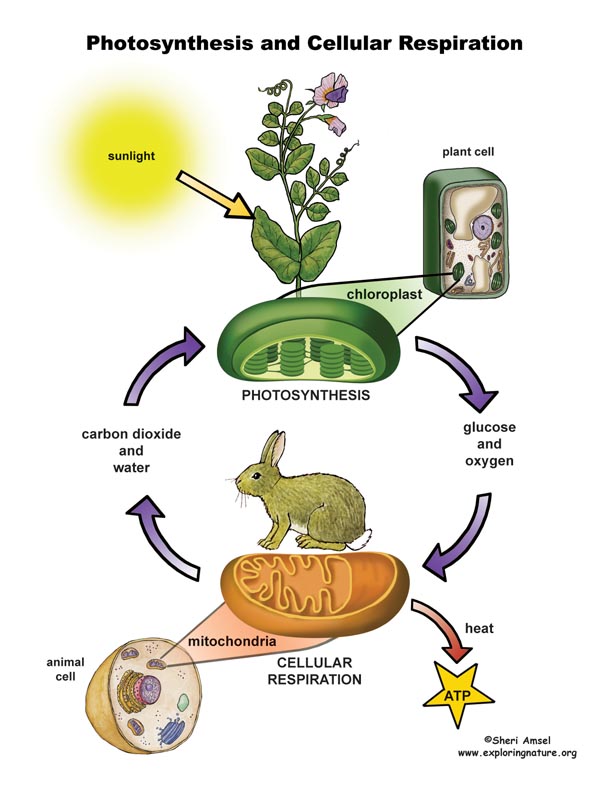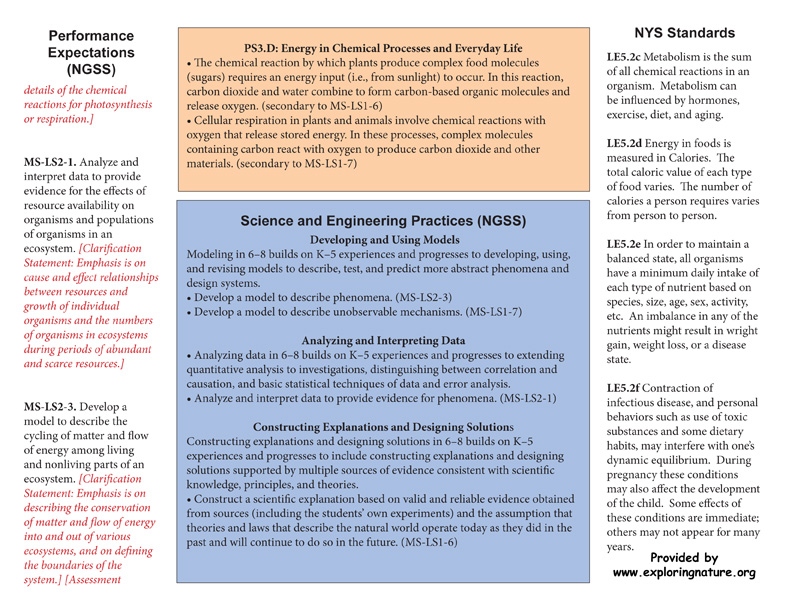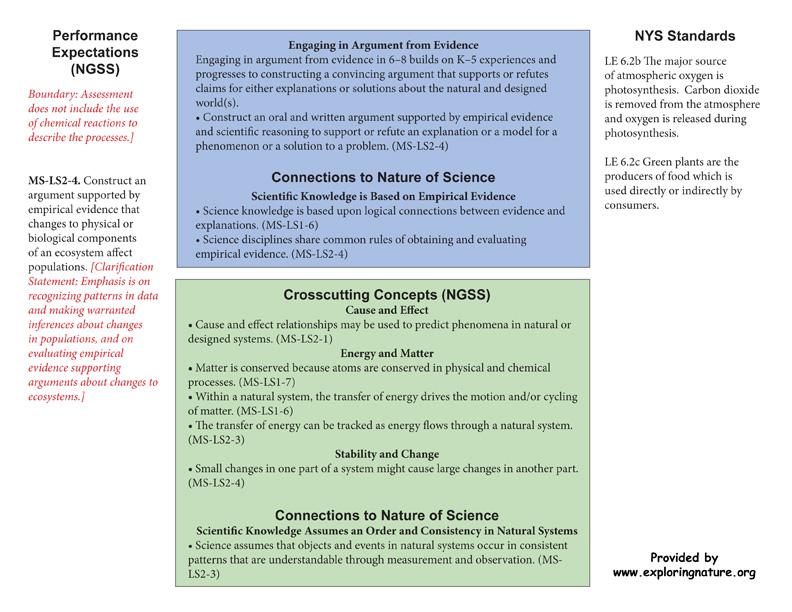

Life Science - Matter and Energy in Organisms and Ecosystems
Disciplinary Core Ideas (NGSS)
LS1.C: Organization for Matter and Energy Flow in Organisms
• Plants, algae (including phytoplankton), and many microorganisms use the energy from light to make sugars (food) from carbon dioxide from the atmosphere and water through the process of photosynthesis, which also releases oxygen. These sugars can be used immediately or stored for growth or later use. (MS-LS1-6)
•Within individual organisms, food moves through a series of chemical reactions in which it is broken down and rearranged to form new molecules, to support growth, or to release energy. (MS-LS1-7)
LS2.A: Interdependent Relationships in Ecosystems
• Organisms, and populations of organisms, are dependent on their environmental interactions both with other living things and with nonliving factors. (MS-LS2-1)
• In any ecosystem, organisms and populations with similar requirements for food, water, oxygen, or other resources may compete with each other for limited resources, access to which consequently constrains their growth and reproduction. (MS-LS2-1)
• Growth of organisms and population increases are limited by access to resources. (MS-LS2-1)
LS2.B: Cycle of Matter and Energy Transfer in Ecosystems
• Food webs are models that demonstrate how matter and energy is transferred between producers, consumers, and decomposers as the three groups interact within an ecosystem. Transfers of matter into and out of the physical environment occur at every level. Decomposers recycle nutrients from dead plant or animal matter back to the soil in terrestrial environments or to the water in aquatic environments. The atoms that make up the organisms in an ecosystem are cycled repeatedly between the living and nonliving parts of the ecosystem. (MS-LS2-3)
LS2.C: Ecosystem Dynamics, Functioning, and Resilience
• Ecosystems are dynamic in nature; their characteristics can vary over time. Disruptions to any physical or biological component of an ecosystem can lead to shifts in all its populations. (MS-LS2-4)
PS3.D: Energy in Chemical Processes and Everyday Life
• The chemical reaction by which plants produce complex food molecules (sugars) requires an energy input (i.e., from sunlight) to occur. In this reaction, carbon dioxide and water combine to form carbon-based organic molecules and release oxygen. (secondary to MS-LS1-6)
• Cellular respiration in plants and animals involve chemical reactions with oxygen that release stored energy. In these processes, complex molecules containing carbon react with oxygen to produce carbon dioxide and other materials. (secondary to MS-LS1-7)
Science and Engineering Practices (NGSS)
Developing and Using Models
Modeling in 6–8 builds on K–5 experiences and progresses to developing, using, and revising models to describe, test, and predict more abstract phenomena and design systems.
• Develop a model to describe phenomena. (MS-LS2-3)
• Develop a model to describe unobservable mechanisms. (MS-LS1-7)
Analyzing and Interpreting Data
• Analyzing data in 6–8 builds on K–5 experiences and progresses to extending quantitative analysis to investigations, distinguishing between correlation and causation, and basic statistical techniques of data and error analysis.
• Analyze and interpret data to provide evidence for phenomena. (MS-LS2-1)
Constructing Explanations and Designing Solutions
Constructing explanations and designing solutions in 6–8 builds on K–5 experiences and progresses to include constructing explanations and designing solutions supported by multiple sources of evidence consistent with scientific knowledge, principles, and theories.
• Construct a scientific explanation based on valid and reliable evidence obtained from sources (including the students’ own experiments) and the assumption that theories and laws that describe the natural world operate today as they did in the past and will continue to do so in the future. (MS-LS1-6)
Engaging in Argument from Evidence
Engaging in argument from evidence in 6–8 builds on K–5 experiences and progresses to constructing a convincing argument that supports or refutes claims for either explanations or solutions about the natural and designed world(s).
• Construct an oral and written argument supported by empirical evidence and scientific reasoning to support or refute an explanation or a model for a phenomenon or a solution to a problem. (MS-LS2-4)
Connections to Nature of Science
Scientific Knowledge is Based on Empirical Evidence
• Science knowledge is based upon logical connections between evidence and explanations. (MS-LS1-6)
• Science disciplines share common rules of obtaining and evaluating empirical evidence. (MS-LS2-4)
Crosscutting Concepts (NGSS)
Cause and Effect
• Cause and effect relationships may be used to predict phenomena in natural or designed systems. (MS-LS2-1)
Energy and Matter
• Matter is conserved because atoms are conserved in physical and chemical processes. (MS-LS1-7)
• Within a natural system, the transfer of energy drives the motion and/or cycling of matter. (MS-LS1-6)
• The transfer of energy can be tracked as energy flows through a natural system. (MS-LS2-3)
Stability and Change
• Small changes in one part of a system might cause large changes in another part. (MS-LS2-4)
Connections to Nature of Science
Scientific Knowledge Assumes an Order and Consistency in Natural Systems
• Science assumes that objects and events in natural systems occur in consistent patterns that are understandable through measurement and observation. (MS-LS2-3)
Performance Expectations (NGSS)
MS. Matter and Energy in Organisms and Ecosystems
Students who demonstrate understanding can:
MS-LS1-6. Construct a scientific explanation based on evidence for the role of photosynthesis in the cycling of matter and flow of energy into and out of organisms. [Clarification Statement: Emphasis is on tracing movement of matter and flow of energy.] [Assessment Boundary: Assessment does not include the biochemical mechanisms of photosynthesis.]
MS-LS1-7. Develop a model to describe how food is rearranged through chemical reactions forming new molecules that support growth and/or release energy as this matter moves through an organism. [Clarification Statement: Emphasis is on describing that molecules are broken apart and put back together and that in this process, energy is released.] [Assessment Boundary: Assessment does not include details of the chemical reactions for photosynthesis or respiration.]
MS-LS2-1. Analyze and interpret data to provide evidence for the effects of resource availability on organisms and populations of organisms in an ecosystem. [Clarification Statement: Emphasis is on cause and effect relationships between resources and growth of individual organisms and the numbers of organisms in ecosystems during periods of abundant and scarce resources.]
MS-LS2-3. Develop a model to describe the cycling of matter and flow of energy among living and nonliving parts of an ecosystem. [Clarification Statement: Emphasis is on describing the conservation of matter and flow of energy into and out of various ecosystems, and on defining the boundaries of the system.] [Assessment Boundary: Assessment does not include the use of chemical reactions to describe the processes.]
MS-LS2-4. Construct an argument supported by empirical evidence that changes to physical or biological components of an ecosystem affect populations. [Clarification Statement: Emphasis is on recognizing patterns in data and making warranted inferences about changes in populations, and on evaluating empirical evidence supporting arguments about changes to ecosystems.]
NYS Standards
Energy in Chemical Processes and Everyday Life
LE 5.1c All organisms require energy to survive. The amount of energy needed and the method for obtaining this energy vary among cells. Some cells use oxygen to release the energy stored in food.
LE 5.1d The methods for obtaining nutrients vary among organisms. Producers, such as green plants, use light energy to make their food. Consumers, such as animals, take in energy-rich foods.
LE5.2a Food provides molecules that serve as fuel and building material for all organisms. All living things, including plants, must release energy from their food, using it to carry on their life processes.
LE5.2b Foods contain a variety of substances, which include carbohydrates, fats, vitamins, proteins, minerals, and water. Each substance is vital to the survival of the organism.
LE5.2c Metabolism is the sum of all chemical reactions in an organism. Metabolism can be influenced by hormones, exercise, diet, and aging.
LE5.2d Energy in foods is measured in Calories. The total caloric value of each type of food varies. The number of calories a person requires varies from person to person.
LE5.2e In order to maintain a balanced state, all organisms have a minimum daily intake of each type of nutrient based on species, size, age, sex, activity, etc. An imbalance in any of the nutrients might result in wright gain, weight loss, or a disease state.
LE5.2f Contraction of infectious disease, and personal behaviors such as use of toxic substances and some dietary habits, may interfere with one’s dynamic equilibrium. During pregnancy these conditions may also affect the development of the child. Some effects of these conditions are immediate; others may not appear for many years.
LE 6.2b The major source of atmospheric oxygen is photosynthesis. Carbon dioxide is removed from the atmosphere and oxygen is released during photosynthesis.
LE 6.2c Green plants are the producers of food which is used directly or indirectly by consumers.
When you research information you must cite the reference. Citing for websites is different from citing from books, magazines and periodicals. The style of citing shown here is from the MLA Style Citations (Modern Language Association).
When citing a WEBSITE the general format is as follows.
Author Last Name, First Name(s). "Title: Subtitle of Part of Web Page, if appropriate." Title: Subtitle: Section of Page if appropriate. Sponsoring/Publishing Agency, If Given. Additional significant descriptive information. Date of Electronic Publication or other Date, such as Last Updated. Day Month Year of access < URL >.
Amsel, Sheri. "NYS Standards with NGSS - MS Matter and Energy in Organisms and Ecosystems" Exploring Nature Educational Resource ©2005-2024. December 15, 2024
< http://www.exploringnature.org/db/view/1918 >



